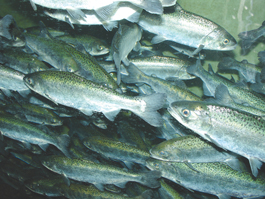home | north bay bohemian index | news | north bay | news article

WALK ON WATER? Back in the early aughts, it was well-nigh possible. My, what a difference seven short years have made!
Spawning Discontent
Chinook fishing to be allowed as the fish prepare to breed. Who thinks this stuff up?
By Alastair Bland
As the state's commercial fishermen and sport anglers look at another cancelled season for Chinook salmon, the California Fish and Game Commission has green-lighted a short recreational season in the Sacramento River. Scheduled to begin in mid-November, the season will allow anglers one Chinook salmon per day between the Red Bluff Diversion Dam and Knights Landing, just miles from their spawning grounds.
As might be expected, not all ocean fishermen are pleased with the decision, though Department of Fish and Game (DFG) biologists assure that no more than 2,000 late-fall run Chinooks, a healthy race of salmon, will be harvested during the six-week season, which will last from Nov. 16 to Dec. 31. The season, explains DFG biologist Scott Barrow, has been carefully slotted to preclude any capture of individuals from struggling salmon runs, namely the winter-run Chinook, an endangered species that spawn in the Sacramento between January and March, and the fall-run Chinook, which spawn from August through October.
The fall-run Sacramento Chinook was until recently the mainstay of the West Coast's ocean fishery but is now teetering at roughly 10 percent of its population level in 2002, when more than 800,000 fall-run fish returned to spawn. Last year, only 66,000 made the migration up the Sac, and officials estimate that just over 122,000 will return this fall. The late-fall-run Chinook, by contrast, has numbered between 10,000 and 20,000 fish for decades and is considered stable.
In late 2008, the state allowed a similar Sacramento River salmon season. From Nov. 1 through Dec. 31, anglers caught 1,732 Chinook, according to DFG biologists who carefully monitored the fishing. The catch included several dozen individuals that might have been fall-run fish, according to Barrow.
This year, the season will be delayed two weeks with the hope that all fall-run Chinook will have spawned and died before the opening day.
"Delaying the season should alleviate that incidental fall run catch," predicts Dan Wolford, who nonetheless opposes the in-river season. Wolford is the science director of the Coastside Fishing Club as well as a voting member of the Pacific Fishery Management Council, whose 13 representatives appeared at a Santa Rosa DFG meeting in late April. All, including Wolford, voiced opposition to the in-river season.
But according to Zeke Grader, director of the Pacific Coast Federation of Fishermen's Association, which represents ocean commercial fishermen, such an in-river fall-run mortality rate is insubstantial. In fact, Grader supports the river season and believes that permitting anglers to catch and eat a small number of fish, even a handful of fall-run salmon, will help to promote and maintain public interest in a waning resource.
"It's important that some people have a chance to enjoy our salmon," Grader says. "This kind of involvement creates the sense of stewardship that ultimately makes people stand up and fight for these fish."
There will even be a short Chinook season allotted to ocean sport anglers along a 120-mile stretch of shoreline between southern Oregon and the coast of Del Norte County. Here, from Aug. 29 to Sept. 7, each fisherman will be allowed two salmon per day in a season intended to target only the relatively healthy Klamath River fish, which will be congregating in the area as they prepare for their spawning migration.
The DFG's Barrow says the 2009 Sacramento River season will benefit the state's economy, which will take an estimated blow of $280 million due to the cancelled ocean salmon season.
"We want to provide some fishing opportunity in what is otherwise a complete closure," Barrow says. "If we lose people's interest in fishing, we'll lose an important source of income in many communities both on the coast and inland."
Not that Central Valley fishing guides are reaping fortunes from the late fall season. Bill Divens, owner and guide at Salmon King Lodge of Red Bluff, reports that he initially lost 75 percent of his business when the salmon season closed. Frank Townley, a fishing guide in Corning, says he has lost almost 30 percent of his income. The 2008 fall season produced scant cash for each of the two guides.
Congress appropriated a disaster-relief bailout last year of $76.6 million for people impacted by the salmon season closure. From that sum, $46.7 million still remains and is being allotted to commercial fishermen, charter boat captains, in-river guides, salmon vendors and other fishing-related businesses. The fund will be paid out across several thousand paychecks, according to David Goldenberg, CEO of the California Salmon Council.
Among the recipients of the fund are approximately a thousand commercial salmon trollers who have little else to fish for now other than halibut, a few black cod and smattering of slime eels, for which a live fish market has developed in East Asia.
But to bring back the salmon, Grader says, fishermen must look beyond minimal in-river harvest and address bigger issues, like irresponsible water management.
"Some of these clowns in Sacramento don't have the guts to tell the Bureau of Reclamation that they're taking too damn much water [for farmland irrigation]. They're treating our rivers like plumbing systems rather than living ecosystems. Catching a few salmon won't hurt the fishery."
But taking all their water will.
Send a letter to the editor about this story.
|
|
|
|
|
|